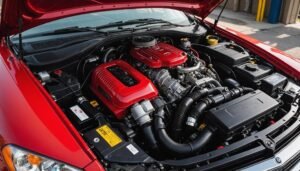It’s a common belief that adding coolant to your car is a straightforward task, but it involves more than just pouring liquid into a reservoir. Understanding the correct procedure, safety precautions, and the right type of coolant is essential for peak engine performance. If you want to guarantee your vehicle runs smoothly and avoid potential overheating issues, you should follow the proper steps. Let’s explore what you need to know to effectively manage your car’s coolant system.
Key Takeaways
- Allow the engine to fully cool before opening the radiator cap to prevent burns and injuries.
- Consult your owner’s manual for the correct type and recommended coolant compatibility for your vehicle.
- Check the coolant reservoir level; fill between the “min” and “max” markers using a funnel.
- Use a proper 50/50 mixture of coolant and distilled water, avoiding mixtures of different coolant types.
- Securely replace the cap after adding coolant and briefly run the engine to check for proper circulation.
Understanding Coolant and Its Purpose

Coolant, also known as antifreeze, plays a crucial role in maintaining your car’s engine temperature. It circulates through the engine and radiator, absorbing heat and preventing overheating. By lowering the freezing point of the liquid, coolant guarantees that your engine operates smoothly in extreme cold temperatures.
It contains additives to prevent corrosion and scale buildup, protecting various components from wear and tear. Additionally, coolant helps in regulating engine temperature, maximizing efficiency and performance.
You’ll find two common types of coolant: ethylene glycol and propylene glycol. Each has its properties and applications, but both perform essential functions. When your engine heats up, coolant expands and increases the pressure in the system, prompting the thermostat to engage or disengage, controlling the flow of coolant. Understanding these aspects will let you appreciate the importance of proper coolant levels and routine maintenance for ideal engine health.
Safety First: Necessary Precautions

Before adding coolant to your car, it’s important to take necessary precautions to secure your safety. Working with coolant can be hazardous if proper measures aren’t taken. Here are some essential safety tips:
Before adding coolant to your car, prioritize safety by taking essential precautions to prevent hazards.
- Allow the engine to cool: Never open the radiator cap when the engine’s hot to avoid steam burns.
- Wear protective gear: Use gloves and safety glasses to protect your skin and eyes from spills.
- Work in a well-ventilated area: Confirm sufficient airflow to avoid inhaling harmful fumes.
- Check for leaks: Inspect hoses and the radiator for any leaks before proceeding.
- Keep a spill kit handy: In case of accidental spills, have absorbent materials available to manage it promptly.
Identifying the Right Coolant for Your Vehicle

Choosing the right coolant for your vehicle is essential for maintaining peak engine performance and preventing overheating. First, check your owner’s manual to identify the specific type of coolant recommended by the manufacturer. Coolants come in various formulations, including ethylene glycol and propylene glycol, with different color codes indicating compatibility. Common types include conventional, extended-life (DEX-COOL), and hybrid organic acid technology (HOAT) coolants.
Ensure you choose a coolant compatible with your vehicle’s materials, such as aluminum or plastic, to avoid corrosion. Pay attention to the mixture ratios; most vehicles require a 50/50 blend of coolant and distilled water. Always avoid mixing different coolant types, as this can lead to chemical reactions that damage your engine. By selecting the right coolant, you’re not just extending your engine’s life; you’re also enhancing its overall efficiency.
Locating the Coolant Reservoir
Once you’ve selected the right coolant for your vehicle, locating the coolant reservoir is the next step. The reservoir is typically a translucent plastic tank connected to the radiator. Here’s how to find it:
Locating the coolant reservoir is essential for maintaining your engine’s optimal temperature; it’s usually a translucent tank near the radiator.
- Pop the hood: Secure it with the prop rod.
- Look for labeling: Check for a “coolantor “antifreezelabel.
- Identify the location: It’s usually near the back of the engine bay or near the radiator.
- Check the color: The reservoir can be clear, yellow, or green, depending on the coolant type.
- Consult the owner’s manual: If you’re having trouble, refer to your vehicle’s manual for specific guidance.
Be certain the engine is cool before you approach the reservoir. Knowing its location will make adding coolant much easier and guarantee your engine remains properly cooled.
Draining and Cleaning the Coolant System (If Necessary)
If your coolant system hasn’t been cleaned in a while, it’s a good idea to drain and clean it before adding new coolant. Start by locating the drain valve, usually at the lowest point of the radiator. Place a suitable container underneath to catch the old coolant. Open the valve and allow the coolant to completely drain out. Once drained, close the valve.
Next, flush the system with water. Fill the radiator with clean water, then run the engine for about ten minutes. This helps remove any contaminants. Turn off the engine and let it cool before draining the water. Repeat the flushing process if necessary until the water runs clear.
After flushing, inspect the system for any leaks and verify the drain valve is securely closed. Now, you’re ready to proceed with adding fresh coolant to guarantee your engine operates efficiently.
Preparing to Add Coolant
Before you add coolant to your car, make certain you’re equipped with the right materials and follow safety precautions. Gathering everything you need beforehand guarantees a smooth process. Here’s what you should have on hand:
- New coolant, suitable for your vehicle
- A funnel to prevent spills
- Protective gloves to keep your hands clean
- Safety goggles for eye protection
- A clean rag for wiping up any spills
It’s essential to check your owner’s manual for specific coolant requirements as different vehicles may use different types. Verify the engine is cool before you start working; this prevents burns and injuries. Working in a well-ventilated area is also a good idea, especially if you’re dealing with old coolant that may emit fumes. By preparing properly, you’ll set the stage for a successful coolant addition, keeping your engine at ideal temperature and performance.
How to Properly Add Coolant
Start by locating the coolant reservoir, which is typically marked with a cap labeled “coolant” or a symbol indicating fluid levels. Once you’ve identified it, make sure your engine is cool to avoid burns. Remove the cap slowly to release any built-up pressure.
Next, check the coolant level; it should be between the “minand “maxmarkers. If it’s low, prepare to add the correct type of coolant for your vehicle, which you can find in the owner’s manual.
Using a funnel, pour the coolant carefully into the reservoir to avoid spills. Fill it to the appropriate level, ensuring not to overfill.
After adding coolant, securely replace the cap and wipe away any spills with a rag. Finally, run your engine for a few minutes to help circulate the new coolant, and double-check the level after the engine cools down.
Checking for Leaks and Ensuring Proper Levels
Regularly checking for leaks and guaranteeing proper coolant levels is essential for maintaining your car’s cooling system efficiency. Start by inspecting your coolant reservoir; if the level is low, refill it with the appropriate coolant. Next, examine the hoses and connections for any signs of wear or damage.
- Look for wet spots or drips under the vehicle.
- Check for cracks or bulges in hoses.
- Make certain clamps are tight and secure.
- Inspect the radiator for any rust or damage.
- Periodically monitor your coolant level after driving.
If you notice any leaks, address them immediately, as even a small leak can lead to significant issues over time. By consistently checking for these signs, you’ll help guarantee your cooling system operates smoothly and effectively, preventing overheating and promoting engine longevity.
Maintaining Your Coolant System Regularly
Alongside checking for leaks, maintaining your coolant system regularly plays a pivotal role in keeping your engine running smoothly. Start by routinely inspecting the coolant’s condition; it should be clean and free from contaminants. If you notice discoloration or debris, it’s time for a flush.
Check your coolant level frequently, topping off as necessary, but avoid overfilling. Use the recommended coolant type specified in your car’s manual to guarantee peak performance.
Keep an eye on the hoses and connections for any signs of wear, cracks, or corrosion, as these can lead to leaks and overheating.
Consider having your coolant system professionally inspected during scheduled maintenance. This includes checking the radiator and thermostat performance. By addressing these aspects, you’ll prevent potential overheating issues and extend your engine’s lifespan. Regular maintenance guarantees your coolant system operates efficiently, safeguarding your vehicle’s performance.
Frequently Asked Questions
Can I Mix Different Types of Coolant?
Mixing different types of coolant is like blending oil and water; it rarely ends well. Coolants come in various formulations, each with unique chemical properties. When combined, they can create unwanted reactions, leading to system corrosion, reduced efficiency, and possible engine damage. It’s best to stick with what’s recommended by your vehicle’s manufacturer. If you’re unsure about what you have, drain the existing coolant before adding a compatible type.
How Often Should I Check My Coolant Levels?
You should check your coolant levels every month, especially before long trips or during extreme weather conditions. Make it a routine part of your maintenance checks. If you notice a drop in levels, investigate possible leaks or other issues. Checking more frequently may be necessary if your vehicle is older or shows signs of overheating. Keeping an eye on coolant levels helps guarantee your engine runs smoothly and prevents costly damage.
What Are Signs of Low Coolant Levels?
You’ll notice signs of low coolant levels if your engine overheats or you see the temperature gauge climbing. Check for coolant leaks under your vehicle, and keep an eye out for a sweet smell, which could indicate a coolant leak. Additionally, the warning light on your dashboard may illuminate. If you hear gurgling noises from the radiator, it’s time to check your coolant levels to avoid engine damage.
Can I Add Coolant When the Engine Is Hot?
You shouldn’t add coolant when the engine’s hot. Doing so can cause coolant to spray out, leading to burns or injuries. It’s best to wait until the engine cools down completely. Check the temperature gauge if you’re unsure. Once it’s cool, safely remove the cap, and then add coolant to the appropriate level. Always use the correct type of coolant specified for your vehicle to guarantee peak performance and prevent damage.
What Happens if I Use the Wrong Coolant?
Using the wrong coolant is like giving your engine a mismatched suit; it just doesn’t fit right. It can lead to corrosion, overheating, and reduced efficiency. You might notice leaks or even find your engine struggling under the strain. Different coolants have varying chemical compositions, which can interact poorly. To keep your engine running smoothly, always pick the manufacturer-recommended coolant. It’s essential for maintaining ideal performance and longevity of your vehicle.













